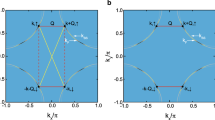Abstract
A phase diagram reflecting the main features of the typical phase diagram of cuprate superconductors has been studied within the framework of the Ginzburg-Landau phenomenology in the vicinity of a tetracritical point, which appears as a result of the competition of the superconducting and insulating pairing channels. The superconducting pairing under repulsive interaction corresponds to a two-component order parameter, whose relative phase is related to the orbital antiferromagnetic insulating ordering. Under weak doping, the insulating order coexists with the superconductivity at temperatures below the superconducting phase transition temperature and is manifested as a weak pseudogap above this temperature. A part of the pseudogap region adjacent to the superconducting state corresponds to developed fluctuations of the order parameter in the form of quasi-stationary states of noncoherent superconducting pairs and can be interpreted as a strong pseudogap. As the doping level is increased, the system exhibits a phase transition from the region of coexistence of the superconductivity and the orbital antiferromagnetism to the usual superconducting state. In this state, a region of developed fluctuations of the order parameter in the form of quasi-stationary states of uncorrelated orbital circular currents exists near the phase transition line.
Similar content being viewed by others
References
P. A. Lee, N. Nagaosa, and X.-G. Wen, cond-mat/0410445.
S. Chakravarty, R. B. Laughlin, D. K. Morr, and C. Nayak, Phys. Rev. B 63, 094503 (2001).
S. Chakravarty, Phys. Rev. B 66, 224505 (2002).
G. Zhao, Phys. Rev. B 64, 024503 (2001).
B. H. Brandow, Phys. Rev. B 65, 054503 (2002).
B. I. Halperin and T. M. Rice, Solid State Phys. 21, 115 (1968).
S. Sachdev, Science 288, 475 (2000).
M. Guidry, L.-A. Wu, Y. Sun, and C.-L. Wu, Phys. Rev. B 63, 134516 (2001).
B. A. Volkov, A. A. Gorbatsevich, Yu. V. Kopaev, and V. V. Tugushev, Zh. Éksp. Teor. Fiz. 81, 729 (1981) [Sov. Phys. JETP 54, 391 (1981)].
J. B. Marston and I. Affleck, Phys. Rev. B 39, 11538 (1989).
D. A. Ivanov, P. A. Lee, and X.-G. Wen, Phys. Rev. Lett. 84, 3958 (2000).
C. Nayak, Phys. Rev. B 62, 4880 (2000).
V. A. Volkov and O. A. Pankratov, Zh. Éksp. Teor. Fiz. 75, 1362 (1978) [Sov. Phys. JETP 48, 687 (1978)].
P. A. Lee, N. Nagaosa, T.-K. Ng, and X.-G. Wen, Phys. Rev. B 57, 6003 (1998); P. A. Lee, cond-mat/0201052.
V. I. Belyavskii and Yu. V. Kopaev, Zh. Éksp. Teor. Fiz. 127, 45 (2005) [JETP 100, 39 (2005)].
V. I. Belyavskii, Yu. V. Kopaev, V. M. Sofronov, and S. V. Shevtsov, Zh. Éksp. Teor. Fiz. 124, 1149 (2003) [JETP 97, 1032 (2003)].
V. I. Belyavskii, Yu. V. Kopaev, Yu. N. Togushova, and S. V. Shevtsov, Zh. Éksp. Teor. Fiz. 126, 672 (2004) [JETP 99, 585 (2004)].
V. I. Belyavskii, V. V. Kapaev, and Yu. V. Kopaev, Pis’ma Zh. Éksp. Teor. Fiz. 81, 650 (2005) [JETP Lett. 81, 527 (2005)].
C. N. Yang, Phys. Rev. Lett. 63, 2144 (1989).
P. Fulde and R. A. Ferrel, Phys. Rev. 135, A550 (1964).
A. I. Larkin and Yu. N. Ovchinnikov, Zh. Éksp. Teor. Fiz. 47, 1136 (1964) [Sov. Phys. JETP 20, 762 (1965)].
V. I. Belyavskii, V. V. Kapaev, and Yu. V. Kopaev, Pis’ma Zh. Éksp. Teor. Fiz. 76, 51 (2002) [JETP Lett. 76, 44 (2002)].
A. A. Abrikosov, Physica C (Amsterdam) 341–348, 97 (2000).
E. G. Maksimov, Usp. Fiz. Nauk 170, 1033 (2000) [Phys. Usp. 43, 965 (2000)].
A. S. Alexandrov and P. E. Kornilovitch, J. Phys.: Condens. Matter 14, 5337 (2002).
A. V. Chubukov, D. Pines, and J. Schmalian, in The Physics of Conventional and Unconventional Superconductors, Ed. by K. H. Bennemann and J. B. Ketterson (Springer, Berlin, 2002).
P. W. Anderson, Science 237, 1196 (1987).
N. N. Bogolyubov, V. V. Tolmachev, and D. V. Shirkov, A New Method in the Theory of Superconductivity (Akad. Nauk SSSR, Moscow, 1958; Consultants Bureau, New York, 1959).
W. Kohn and J. M. Luttinger, Phys. Rev. Lett. 15, 524 (1965).
V. I. Belyavsky and Yu. V. Kopaev, Phys. Rev. B 67, 024513 (2003).
V. I. Belyavsky and Yu. V. Kopaev, Phys. Lett. A 322, 244 (2004).
V. I. Belyavsky, Yu. V. Kopaev, and Yu. N. Togushova, Phys. Lett. A 338, 69 (2005).
Y. Ren, J.-H. Xu, and C. S. Ting, Phys. Rev. Lett. 74, 3680 (1995).
A. Ghosh and S. K. Adhikari, Phys. Rev. B 60, 10401 (1999).
E. M. Lifshitz and L. P. Pitaevskii, Course of Theoretical Physics, Vol. 5: Statistical Physics, 2nd ed. (Nauka, Moscow, 2001; Pergamon, New York, 1980), Part 2.
V. N. Muthukumar and Z. Y. Weng, Phys. Rev. B 65, 174511 (2002).
L. D. Landau and E. M. Lifshitz, Course of Theoretical Physics, Vol. 5: Statistical Physics, 4th ed. (Nauka, Moscow, 1995; Butterworth, London, 1999), Part 1.
M. Franz, Z. Tešanović, and O. Vafek, Phys. Rev. B 66, 054535 (2002).
Z. A. Xu, N. P. Ong, Y. Wang, et al., Nature 406, 486 (2000).
G. E. Volovik and L. P. Gor’kov, Zh. Éksp. Teor. Fiz. 88, 1412 (1985) [Sov. Phys. JETP 61, 843 (1985)].
L. D. Landau and E. M. Lifshitz, Electrodynamics of Continuous Media (Nauka, Moscow, 1982; Pergamon, Oxford, 1984).
Y. Wang, L. Li, M. J. Naughton, et al., cond-mat/0503190.
M. Oda, T. Matsuzaki, N. Momono, and M. Ido, Physica C (Amsterdam) 341–348, 847 (2000).
G. Zheng, P. L. Kuhns, A. P. Reyes, et al., cond-mat/0502117.
Author information
Authors and Affiliations
Additional information
__________
Translated from Zhurnal Éksperimental’no\(\overset{\lower0.5em\hbox{$\smash{\scriptscriptstyle\smile}$}}{l} \) i Teoretichesko\(\overset{\lower0.5em\hbox{$\smash{\scriptscriptstyle\smile}$}}{l} \) Fiziki, Vol. 128, No. 3, 2005, pp. 525–543.
Original Russian Text Copyright © 2005 by Belyavsky, Kopaev, Smirnov.
Rights and permissions
About this article
Cite this article
Belyavsky, V.I., Kopaev, Y.V. & Smirnov, M.Y. Tetracritical point and staggered vortex currents in superconducting state. J. Exp. Theor. Phys. 101, 452–467 (2005). https://doi.org/10.1134/1.2103213
Received:
Issue Date:
DOI: https://doi.org/10.1134/1.2103213




